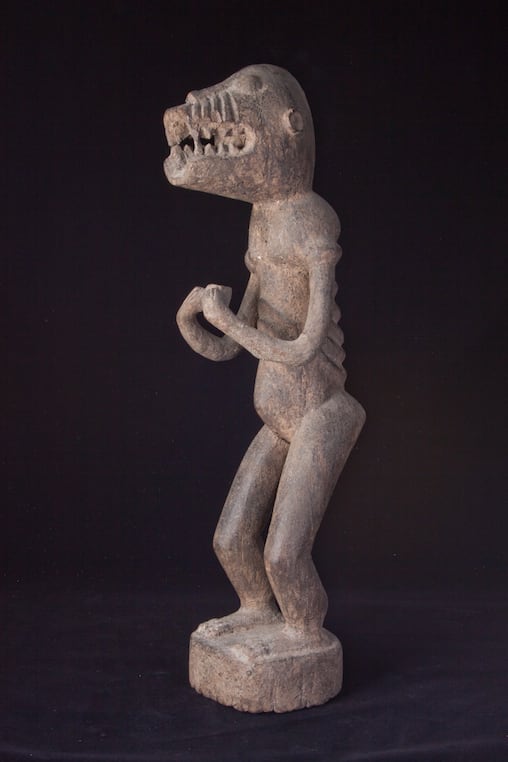Baule Wooden Gbekre (Mbra) Monkey Sculpture, 19th Century CE - 20th Century CE
Wood
74.9 x 15.9 cm
29 1/2 x 6 1/4 in
29 1/2 x 6 1/4 in
PF.4683 (LSO)
This menacing and highly encrusted figure is a Mbra (or Gbreke) monkey figure from the Baule group of the Ivory Coast. It is a classical example of the genre, depicting...
This menacing and highly encrusted figure is a Mbra (or Gbreke) monkey figure from the Baule group of the Ivory Coast. It is a classical example of the genre, depicting an emaciated monkey with hands together, standing upon an integral base. The head is snarlingly savage, with protuberant eyes and a central head crest running into the nose. The nose is flanked with incised whiskers (?), and the teeth are exposed. The shoulders are powerful, giving way to a gaunt thorax on which every rib is clearly marked. The legs, slightly bent, are of roughly normal dimensions, while the arms are emaciated, coming together to hold an alms cup at chest height. The entire surface is encrusted with a dark patina, while the base has considerable use wear.
The Baule live across the Ivory Coast area, and have an economy based primarily on sedentary agriculturism and a strong ritual and artistic heritage. Blolo bian (male) and Blolo bla (female) spirit spouses – wooden representations of otherwordly partners – are perhaps the Baule’s greatest artistic and psycho-social achievement. The Baule are also known for sculptures representing bush spirits (Asie usu) – mischievous and potentially malevolent inhabitants of the “bush”, or dark country beyond the boundary of the village – monkeys, and three types of masks that are used in the celebration of good harvests, mourning, and the visits of important dignitaries.
This monkey is called “Mbra” (or Gbreke), and is a potent symbol for the Baule. Accounts of their use vary: they were often stood up in Baule villages and are used to assist in trance divination rituals in which it helped the diviner transmit messages to the hereafter. It is also claimed to have served a protective function to keep malevolent spirits away from men’s societies. They are considered so powerful that women are not allowed to see them except for diviner consultations; they are usually kept in the bush away from prying eyes, and fed” on libations of eggs and blood; dogs are usually sacrificed to this end.
This is a superb and impactive piece of African art.
The Baule live across the Ivory Coast area, and have an economy based primarily on sedentary agriculturism and a strong ritual and artistic heritage. Blolo bian (male) and Blolo bla (female) spirit spouses – wooden representations of otherwordly partners – are perhaps the Baule’s greatest artistic and psycho-social achievement. The Baule are also known for sculptures representing bush spirits (Asie usu) – mischievous and potentially malevolent inhabitants of the “bush”, or dark country beyond the boundary of the village – monkeys, and three types of masks that are used in the celebration of good harvests, mourning, and the visits of important dignitaries.
This monkey is called “Mbra” (or Gbreke), and is a potent symbol for the Baule. Accounts of their use vary: they were often stood up in Baule villages and are used to assist in trance divination rituals in which it helped the diviner transmit messages to the hereafter. It is also claimed to have served a protective function to keep malevolent spirits away from men’s societies. They are considered so powerful that women are not allowed to see them except for diviner consultations; they are usually kept in the bush away from prying eyes, and fed” on libations of eggs and blood; dogs are usually sacrificed to this end.
This is a superb and impactive piece of African art.



